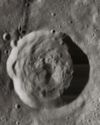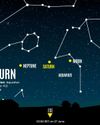
Smaller planets might be born when gas and dust are squeezed between larger worlds, like the filling in a cosmic sandwich. The newly suggested process , dubbed ‘sandwiched planet formation’, would occur in the massive discs of planet-birthing gas and dust that swirl around stars in their infancy. Around 4.5 billion years ago, the Solar System itself would have existed as one such disc around the infant Sun, from which the planets arose.
This new theory of planet birth was developed by researchers at the University of Warwick. According to sandwiched planet formation, two large planets already present in the protoplanetary disc would restrict the flow of dust inwards through the flattened cloud of gas and dust. This results in matter collecting between the planets, with dense patches of the protoplanetary disc collapsing to birth planets. This gathering of gas and dust between the original two large planets would then form a middle planet smaller than its two outer companions. The theory put forward by the team still needs to be confirmed, but if it is, it could explain how smaller planets like Mars are born.
This story is from the Issue 146 edition of All About Space UK.
Start your 7-day Magzter GOLD free trial to access thousands of curated premium stories, and 9,000+ magazines and newspapers.
Already a subscriber ? Sign In
This story is from the Issue 146 edition of All About Space UK.
Start your 7-day Magzter GOLD free trial to access thousands of curated premium stories, and 9,000+ magazines and newspapers.
Already a subscriber? Sign In

LONG AGO, A LAKE ON MARS MAY HAVE BEEN SPRAWLING WITH MICROBES
Curiosity discovered manganese oxide in bedrock in a Martian region that may have been a shoreline billions of years ago

MOON TOUR HELL
Finding this fascinating crater isnt as hard as its name suggests...

THIS MONTH'S PLANETS
Most of the planets are tricky targets this month, but our guide will help you locate them

UNIVERSE BEFORE TIME
Could the existence of a mirror-image cosmos before the Big Bang solve some of the biggest mysteries in astronomy?

CLIMATE CHANGE IN THE SOLAR SYSTEM
Alongside Earth, our planetary neighbourhood is changing, but it’s not for the better…

Stars give tiny planets a gravitational 'squeeze' to strip away their atmospheres
A scientist has learned more about the violent processes that rip atmospheres away from planets, finding that squashing and squeezing by a parent star can contribute to this process.

The Milky Way's halo is filled with ‘magnetic doughnuts' as wide as 100,000 light years
The outer halo of the Milky Way is filled with magnetic fields that take the shape of vast doughnuts with diameters ranging from 12,000 to 100,000 light years, with the heart of our galaxy at their centre.

The Pentagon wants the commercial space reserve to support military satellites in orbit
The US Department of Defense is developing a plan to use the ever-growing American commercial space industry for national security purposes.

DOES A COSMIC 'GLITCH' IN GRAVITY CHALLENGE ALBERT EINSTEIN'S GREATEST THEORY?
Gravity changes once you reach a cosmic scale

DEEP SKY CHALLENGE : STELLAR TREASURES OF THE ARCHER AND SCORPION
Summer skies are stuffed full of amazing objects for your telescope - if you're prepared to stay up late